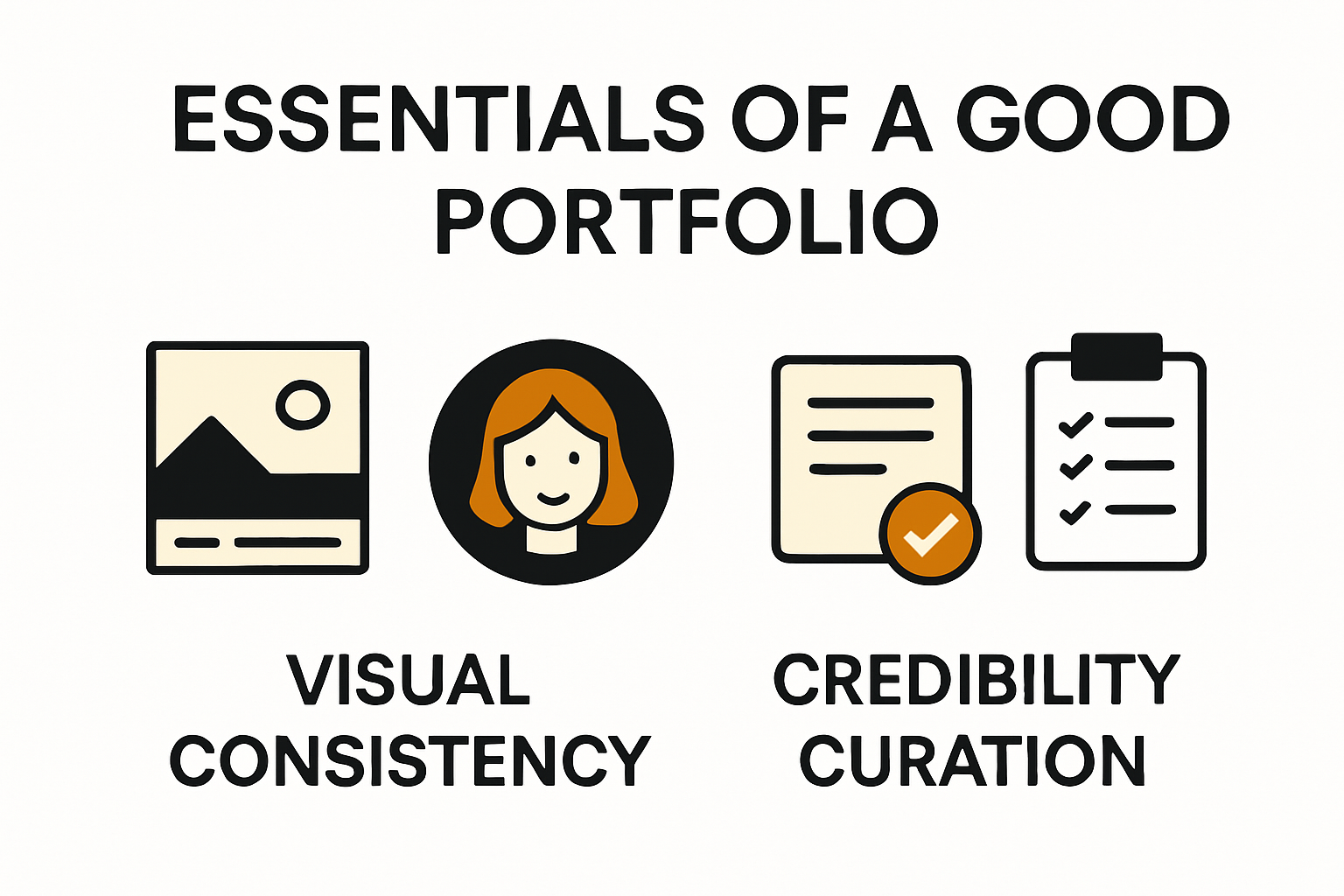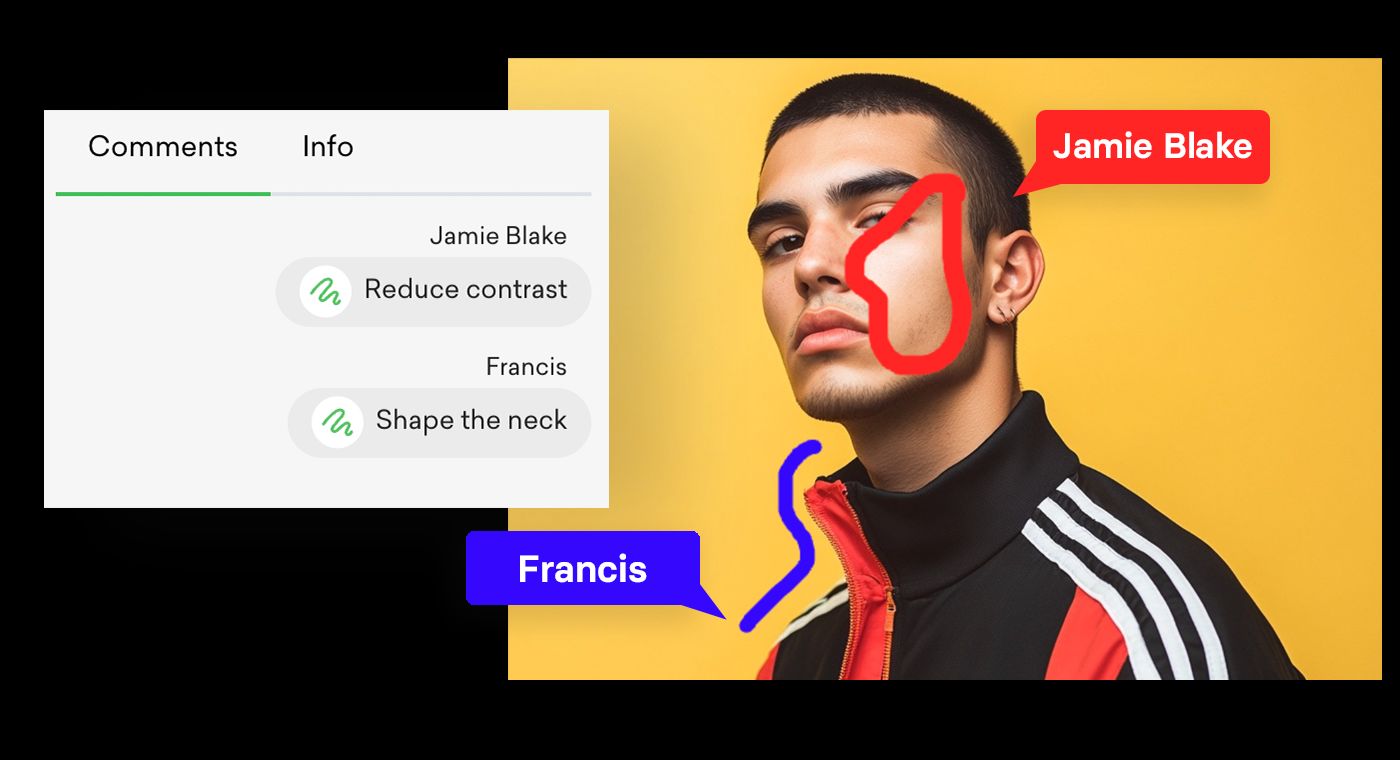A creative portfolio is more than a gallery of pretty pictures. It is now your number one selling tool, shaping first impressions in seconds. Yet only 15 to 20 carefully curated pieces will actually grab the right attention, not a sprawling collection of everything you have ever made. This flips the usual advice upside down and proves that quality and storytelling beat sheer volume every single time.
Table of Contents
- Key Elements Of A Good Portfolio
- Showcasing Your Best Work Effectively
- Tailoring Your Portfolio To Your Audience
- Optimizing Presentation And User Experience
Quick Summary
| Takeaway | Explanation |
|---|---|
| Visual Consistency is Key | A professional portfolio should maintain a cohesive visual style through layout, color palette, typography, and imagery to effectively reflect your brand. |
| Diverse Representation of Work | Include a variety of projects that showcase technical skills and authenticity, focusing on quality over quantity to present your unique artistic perspective. |
| Tailor Your Portfolio for the Audience | Customize your portfolio presentation based on audience expectations by researching specific industry needs and aligning content accordingly. |
| Optimize Technical Performance | Ensure your portfolio loads quickly and navigates smoothly across different devices, incorporating responsive and accessible design elements to enhance user experience. |
| Narrative and Presentation Matter | Go beyond final products by revealing your creative process and maintaining a logical layout that tells a compelling story about your work. |
Key Elements of a Good Portfolio
A professional portfolio represents more than just a collection of work. It serves as a visual narrative of your creative journey, professional capabilities, and unique artistic vision. For photographers, videographers, and creative professionals, crafting a portfolio that truly stands out requires strategic thinking and careful curation.

Visual Consistency and Professional Design
The design of your portfolio speaks volumes before a viewer even examines your individual projects. According to Alderson Loop, maintaining a consistent visual style is crucial. This means developing a cohesive approach to layout, color palette, typography, and imagery that reflects your professional brand.
Consider how each element contributes to your overall presentation. Color schemes should complement your work without overwhelming it. Typography must be clean and readable, ensuring that text elements enhance rather than distract from your visual content. The goal is to create a seamless visual experience that guides viewers through your work with intuitive navigation.
Diverse and Authentic Work Representation
California College of the Arts emphasizes the importance of showcasing a variety of mediums and techniques. This diversity demonstrates your versatility and willingness to explore different creative approaches. However, authenticity remains paramount. Each piece should reflect your unique perspective and artistic voice.
When selecting work for your portfolio, focus on quality over quantity. Include projects that:
- Showcase technical skill: Demonstrate your proficiency across different styles and techniques
- Tell a story: Highlight projects that reveal your problem-solving abilities and creative thinking
- Represent your best work: Choose pieces that genuinely represent your current skill level and professional aspirations
Credibility and Professional Presentation
Kansas State University’s College of Business recommends incorporating elements that build professional credibility. This includes creating a clear homepage, providing straightforward contact information, and integrating client testimonials.
Testimonials offer social proof of your capabilities and help potential clients understand the real-world impact of your work. Consider including brief case studies that outline specific challenges you addressed, your creative approach, and the successful outcomes. This narrative approach transforms your portfolio from a mere image gallery into a compelling professional story.
Remember, a good portfolio is not static. Regularly update it to reflect your growth, newest skills, and most recent projects. Your portfolio should evolve as you do, always presenting the most current and impressive representation of your creative capabilities.
To help you assess the essential elements of a standout portfolio, the table below summarizes the key features discussed in this section:
| Element | Description | Example Actions |
|---|---|---|
| Visual Consistency | Unified approach to layout, color, typography, and imagery | Use consistent color palette |
| Diverse & Authentic Representation | Mix of mediums and techniques reflecting your true creative voice | Include work in different styles |
| Credibility | Signals trustworthiness, such as testimonials and case studies | Add client testimonials, case studies |
| Professional Presentation | Clean homepage, clear contact info, and logical navigation | Clear homepage and navigation |
| Up-to-Date Content | Regularly refreshed with recent, relevant work | Remove old/outdated projects |
Showcasing Your Best Work Effectively
Presenting your creative work requires more than simply displaying finished projects. A strategic approach transforms your portfolio from a mere collection of images into a compelling narrative of your professional capabilities.
Curating Quality Over Quantity
Prospects UK highlights that an exceptional portfolio typically contains 15 to 20 pieces spanning three to four projects. Selectivity is key. Each piece should demonstrate a unique aspect of your creative range, technical proficiency, and problem-solving abilities.
When curating your work, consider these critical selection criteria:
- Technical Excellence: Choose pieces that showcase your highest skill level
- Diversity: Include projects representing different styles, techniques, and creative challenges
- Relevance: Select work aligned with the specific opportunities or audiences you’re targeting
Revealing Your Creative Process
AIGA’s Eye on Design emphasizes the importance of celebrating your entire creative journey. Don’t just showcase polished final products. Transparency about your problem-solving approach can be equally compelling.
Consider including:
- Initial sketches and conceptual drafts
- Mood boards and inspiration references
- Annotated design iterations
- Brief project context explaining creative challenges
This approach provides potential clients or employers insight into your thinking process, demonstrating not just what you create, but how you create.
Presentation and Narrative Design
BBC Bitesize recommends a strategic presentation style that highlights your work without overwhelming viewers. The goal is to create a clear, logical layout that guides viewers through your creative narrative.
Effective presentation techniques include:
- Consistent visual formatting
- Thoughtful sequencing of projects
- Concise project descriptions
- Clear labeling and context for each piece

Remember that your portfolio is more than a visual resume. It’s a storytelling platform that communicates your unique creative voice, professional capabilities, and potential for future innovative work.
Ultimately, an effective portfolio invites viewers into your creative world, offering a glimpse of your skills, passion, and potential. Invest time in crafting a presentation that is as creative and thoughtful as the work it represents.
Tailoring Your Portfolio to Your Audience
Creating a compelling portfolio is not a one-size-fits-all approach. Each audience requires a nuanced presentation that speaks directly to their specific interests, expectations, and professional context.
Understanding Your Audience Expectations
Fiveable emphasizes the critical importance of researching and understanding the preferences of your target audience. Different viewers require different approaches. A potential employer in a marketing agency will seek different portfolio elements compared to a private client looking for wedding photography.
Strategic audience targeting involves:
- Researching the specific industry or client sector
- Understanding the technical and creative expectations
- Adapting your portfolio’s tone and content accordingly
For instance, a corporate client might appreciate more structured, professional presentations, while a creative agency might value experimental and boundary-pushing work.
Customizing Portfolio Presentation
UK Government Digital Service recommends creating a portfolio with clear navigation and accessibility. This means developing a flexible presentation that can be easily modified to suit different audiences.
Consider creating multiple portfolio versions:
- A comprehensive version for in-depth review
- A condensed version for quick professional screenings
- Specialized versions targeting specific industry niches
Each version should maintain your core professional identity while highlighting the most relevant aspects of your work for that specific audience.
Quality and First Impressions
Prospects.ac.uk advises prioritizing quality over quantity. This principle becomes even more critical when tailoring your portfolio. Each piece should not just be excellent but strategically selected to resonate with your intended audience.
Key considerations for audience-specific portfolios:
- Technical Relevance: Showcase projects demonstrating skills most valued by the specific audience
- Narrative Alignment: Frame your projects to reflect the storytelling style preferred by your target viewers
- Professional Context: Include project descriptions that highlight your understanding of the audience’s specific challenges and requirements
Before finalizing your portfolio, seek feedback from professionals in your target industry. Their insights can help you refine your presentation, ensuring that your work speaks directly to the right audience.
Remember, a well-tailored portfolio is more than a collection of work. It’s a strategic communication tool that demonstrates your professional understanding, creative versatility, and ability to meet specific client or employer needs.
Below is a table summarizing strategies for tailoring your portfolio to different audiences:
| Portfolio Type | Description | When to Use |
|---|---|---|
| Comprehensive Version | In-depth, full showcase of work | Agency, in-depth job application |
| Condensed Version | Short, highlights key projects | Quick screenings, introductory contact |
| Specialized Version | Focused on a specific industry or niche | Pitching to specific clients or sectors |
| Audience-Aligned Edits | Customized language, style, and project picks | When targeting unique audiences |
Optimizing Presentation and User Experience
A portfolio’s effectiveness extends beyond its content. The user experience and presentation play crucial roles in how your work is perceived and engaged with by potential clients and employers.
Technical Performance and Accessibility
AIGA highlights the critical importance of technical optimization in portfolio design. Websites must load quickly and function smoothly across different devices and platforms. Image management becomes paramount, requiring strategic resizing and compression techniques that maintain visual quality while ensuring rapid loading times.
Key technical considerations include:
- Responsive Design: Ensure your portfolio looks excellent on desktop, tablet, and mobile devices
- Fast Loading: Compress images without sacrificing visual clarity
- Clear Navigation: Create intuitive menus and straightforward user paths
Design Clarity and User Engagement
Toptal recommends presenting your work with a clean, uniform approach that guides viewers through your creative journey. Avoid complex animations or unconventional layouts that might distract from your actual work. Instead, focus on creating a streamlined visual experience that allows your projects to speak for themselves.
Effective presentation strategies involve:
- Consistent visual styling across all project displays
- Clear, concise project summaries
- Logical sequencing of work samples
- Minimal design elements that complement rather than compete with your content
Mobile and Interactive Optimization
Adobe Certified Professional emphasizes the growing importance of mobile-friendly portfolio design. With increasing numbers of professionals reviewing portfolios on smartphones and tablets, your presentation must be seamlessly adaptable.
Consider implementing:
- Touch-friendly interfaces: Large, easily tappable navigation elements
- Adaptive layouts: Designs that restructure elegantly across screen sizes
- Performance optimization: Lightweight design that loads quickly on mobile networks
Beyond technical considerations, remember that user experience is about creating an emotional connection. Your portfolio should not just display work but tell a story. Each interaction should feel intuitive, engaging, and reflective of your professional brand.
Invest time in testing your portfolio across different devices and soliciting feedback. What seems clear to you might be confusing to others. Continuous refinement is key to creating a portfolio that not only showcases your work but provides an exceptional user experience that leaves a lasting impression.
Frequently Asked Questions
What are the key elements of a good portfolio in 2025?
A good portfolio should have visual consistency, diverse and authentic work representation, professional presentation, tailored content for the target audience, and optimized technical performance.
How many pieces should I include in my portfolio?
It’s recommended to include 15 to 20 carefully curated pieces that showcase your best work, focusing on quality over quantity to grab the right attention.
How can I tailor my portfolio for different audiences?
Research your audience’s expectations and customize your portfolio presentation accordingly. Create different versions for specific industries or clients to highlight relevant skills and projects.
What technical aspects should I consider for my portfolio design?
Focus on ensuring fast loading times, responsive design for various devices, clear navigation, and accessibility to enhance user experience.
Ready to Show Off a Portfolio That Stands Out in 2025?
You have learned how a thoughtfully curated, visually consistent portfolio makes all the difference in catching the attention of clients and decision-makers. But putting this into practice gets overwhelming fast. You’re stuck managing high-res files, wrestling with clunky uploads, and struggling to present your work with the polish it deserves. Imagine sharing a gallery that instantly reflects your creative voice, gives you full control over permissions, and lets clients comment or select images right inside a stunning visual layout. That freedom is exactly what Pikd offers.

See what happens when the way you showcase your work is as creative and professional as the projects themselves. Take your portfolio from “just another folder” to a branded experience that truly sells your story. Visit Pikd.io today and create a portfolio your clients—and the industry—will remember. There has never been a better time to present your best work with confidence.

































